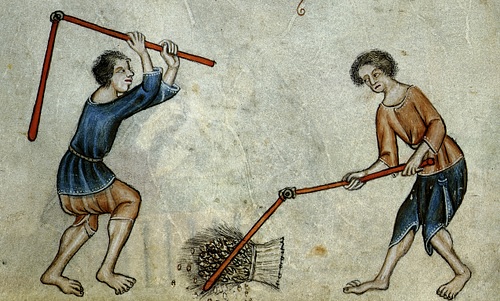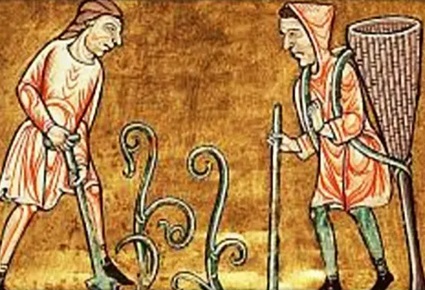When Christianity was first established in England in the years following the mission of St. Augustine of Canterbury (c. 597), the construction and maintenance of churches was generally funded through the largesse of royal patronage. As Christianity spread and parishes proliferated, however, the clergy and kings began to look for more permanent methods of supporting the temporal needs of the growing Church. Eventually this obligation came to be expected and then imposed on the Christian population, enforced by civil law. Nobody knows exactly when the material support of the Church became mandatory in England; there is evidence it may have begun as early as the 7th century, for St. Bede, in his Epistle to Egbert, Bishop of York, complains that the laity are compelled to pay “tribute” to their bishops despite the bishops’ lack of ministry in remote areas:
For we have heard it reported, that there are many country-houses and hamlets of our nation situated on inaccessible mountains and thick forests, where, for many years, no bishop comes to perform any of the duties of holy ministry or divine grace, yet none of these is free from paying tribute to the bishop; and yet not only is there no bishop among them to confirm by the laying on of hands those who have been baptized, but they have not even any teacher to instruct them in the truth of the faith, and in the difference between good and evil. [1]
Whatever the origin of the obligation to support the Church, the obligatory support of the Church seems to have been firmly entrenched by the middle Anglo-Saxon period, around the year 800.
Rather than levy a single tithe across the board, the Anglo-Saxons preferred to support the Church through a multiplicity of offerings, using a fee structure whereby specific payments were made in recompense for specific services performed by the clergy, as well as for their general maintenance. Most of these offerings are unknown to modern Catholics, as they were gradually phased out in the centuries after the Norman Conquest (1066) largely to be replaced by the general tithe, a tenth part of the increase arising from the profits of land and stock, allotted to the clergy for their support or devoted to religious or charitable uses.
In this article, we will review the different obligations paid by Anglo-Saxons to support the Church in the pre-Norman era. In speaking of these offerings, we will see frequent use of the Middle English words scot and bot. Scot comes from the Old English sċeot or ġescot, which means “contribution,” “payment,” or “tax.” The word bot is an Old English word meaning “help,” “relief,” or “advantage.”

Church-scot: The church-scot was a donation of grain levied on every “hide” of land (a hide is roughly equivalent to 150 U.S. acres or 60 European hectares), payable to the clergy specifically for their support. The levy was collected at harvest time and payable to the parish on Martinmas (November 11). It is unclear how the church-scot offering was quantified, but based on the scale of the levy it must have been substantial. It was generally paid in grain, but could be paid in livestock or other crops. This fee was one of the most enduring of the Anglo-Saxon age, surviving in some places until 1300.
Soul-scot: A fee paid at the time of death in recompense to the priest for burial and services to be said for the deceased. It was paid out of the estate of the deceased. It was customarily paid at the grave of the deceased. After the Norman Conquest, this was replaced by a separate stipend called a “mortuary.”
Church-bot: Whereas church-scot was paid to support the living of the clergy, church-bot was paid to maintain the church building. The payment of the church-bot as the means for maintaining parishes is well-attested in the latter Anglo-Saxon period, around the year 900. In the latter Middle Ages, maintenance of the church building would be assumed by the congregation in general, often through the mediation of guilds. (2)
Light-scot: This fee was instituted later, after the year 1000, and related to providing lighting for the parish. The light-scot was payable three times per year in the form of bulk donations of wax. In addition to this, individuals were expected to make a donation of a candle every year on Candlemas (February 2). In latter medieval England, this function would be taken over by Lighting Guilds, although the personal Candlemas donation continued on almost to Reformation times.
Plough-alms: This was a payment made by the heads of families for each plough. Attested after 900, the origin of plough-alms is uncertain, but it is believed it was offered for the success of ploughing. Fields were blessed during the Rogation Day processions during the fifth week after Easter, which required the priest to process throughout his parish territory. The plough-alms may have been in recompense for this service. Like church-scot, plough-alms survived into the 1300s.
Rome-penny: Also called the Rome-scot, Romfeoh, or Peter’s Pence was an offering made to the Pope. It appears to have begun under the reign of King Alfred (871-886) as a gift of the king, but the monarchs later extended this obligation to all their subjects as well. It was sometimes called the “smoke-penny” because it was levied at a rate of one penny per hearth. The money was collected by the local clergy, funneled up to the bishop, then the archbishop, who passed it on to the papal legate. This was paid until the Reformation.
Tithes: The above plethora of fees was largely displaced by the tithe, an annual obligation on all landowners and workers to pay a tenth of their increase. The tithe was pushed as early as the 8th century, was made obligatory on landowners in the 10th, and gradually displaced most of the above offerings throughout the high Middle Ages. Tithes were enforced by civil law and defaulters were punished harshly; a defaulter would be visited by the king’s agents, who would seize a tenth for the Church, leave another tenth for the defaulter, and keep the remaining eight tenths for the king. Tithes were paid twice per year depending on the type of tithe: tithes of animals were paid at Pentecost, those of fruits by the autumn equinox. By the late Middle Ages, the obligation of the tithe had been extended beyond agricultural increase to every kind of activity: wool, milk, butter, cheese, fowl, eggs, honey, hay, beans, hemp, peas, orchard fruit, brushwood, reeds, craft-work, and even bracken collected for animal bedding were all subject to the tithe. Tithes were also expected of industrial workers like smiths, cobblers, etc. but since it was difficult to reckon what constituted a tenth, they usually paid a monetary fee. For more on tithing, please read our article “Catholics and Tithing.”
Secret tithes: Finally, we must mention secret tithes, which were paid during Lent and at the time of sacramental confession, usually as a kind of penitential restitution by persons who had neglected or evaded their tithes and were concerned about their salvation. One of the most common clauses in one’s will was a donation to the Church “for tithes forgotten.”
The information is this article is largely taken from Nicholas Orme. Going to Church in Medieval England (Yale University Press: New Haven and London, 2021), pp. 30-34
(1) “Letter of Bede to Bishop Egbert.” J. A. Giles (ed./transl.), The Historical Works of the Venerable Bede, Vol. II: biographical writings, letters and chronology (London 1845), online at the Internet Archive, pp. 138-155. The Latin can be found in Bede’s Opera historica, ed. Charles Plummer, Vol. 1(Oxford, 1896), pg. 410: Audiumus enim, et fama est, quia multae uillae as viculi nostrae gentis in montibus sint inaccessis ac saltibus dumosis positi, ubi numquam multis transeuntibus annis sit visus antistes, qui ibidem aliquid ministerii aut gratiae caelestis exhibuerit; quorum tamen ne unus quidem a tributis antistiti reddendis esse possit immunis; nec solum talibus locis desit antistes, qui manus impositione baptizatos, confirmet, verum etiam omnis doctor, qui eos vel fidei veritatem vel discretionem bonae ac malse actionis edoceat, absit.
(2) For the work of guilds in supporting the needs of English parishes in the latter Middle Ages, see Virginia Bainbridge, Gilds in the Medieval Countryside (Boydell Press: Rochester, NY, 1996).
Phillip Campbell, “Supporting the Church in Anglo-Saxon England,” Unam Sanctam Catholicam, July 28, 2024. Available online at https://www.unamsanctamcatholicam.com/2024/07/2024/07/supporting-the-church-in-anglo-saxon-england

